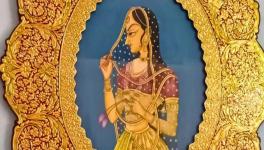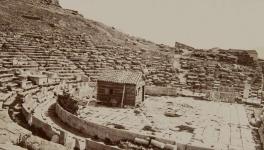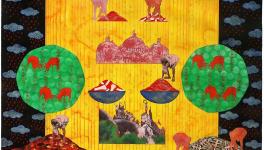Madhya Pradesh: For Young Baiga Painters, Art is Inheritance But Not a Secure Livelihood
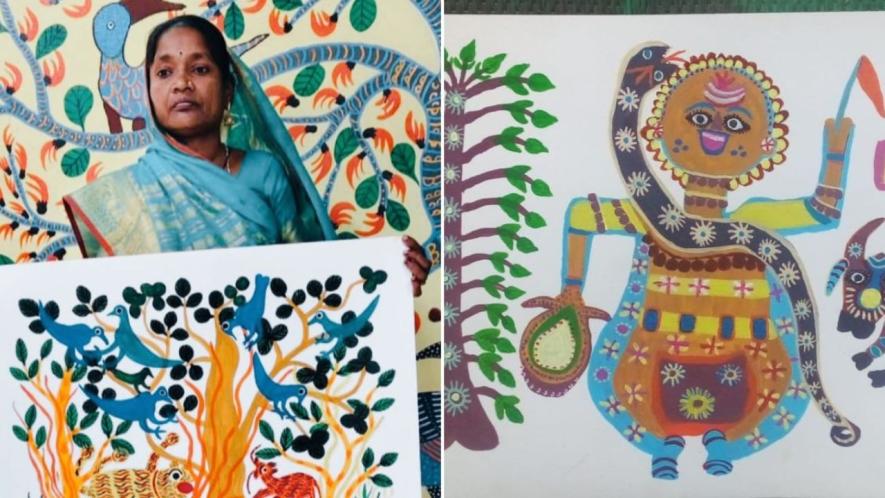
Sakun Bai showing her paintings (Photo - Satish Bhartiya, 101Reporters)
Umaria, Madhya Pradesh: “Baiga painting is our identity, expression, and legacy of existence,” said Amarsiya Baiga (25), a Baiga painter from Madhya Pradesh’s Umaria district. “If its actions cease, then the identity of the society ends. Therefore, we too must keep our identity alive.”
For the younger generation of Baiga artists, the struggle is not only to preserve this heritage but also to make a living from it. Even as their work reaches exhibitions across India, earnings remain meagre.
Amar Baiga, (25) began painting in 2018. His income collapsed during the Covid-19 years and has only partially recovered. “I get Rs 400- Rs 700 rupees for one painting, sometimes Rs 1,000 if a customer values it,” he said. “On average, we earn Rs 6,000-Rs 9,000 rupees a month, which is not enough for a decent life.”
A simple Baiga painting takes about one to two days to make. But a detailed and large scale painting can take anywhere between a week and a month, he added.
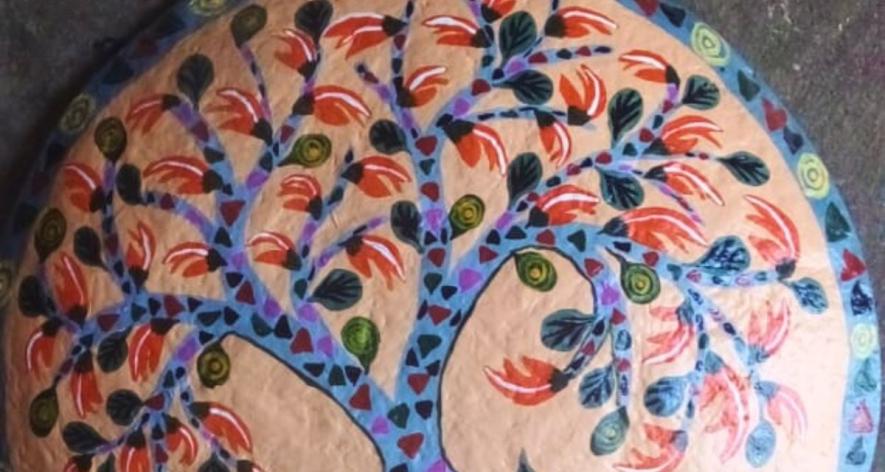
A painting made by Amar Baiga (Photo - Satish Bhartiya, 101Reporters)
Amarsiya, who paints gods and goddesses, told 101Reporters that some customers order her works but never return to collect them. And there are times when others reject pieces over small flaws. On average, she earns no more than Rs 2,000- Rs 3,000 a month.
But she does not want to give it up.
“Of course I am getting less money in an art like painting,” she said. “But painting has become a way of life for us. We cannot give it up, because of its expression, self-satisfaction and love. As we paint, we feel complete. There is also hope that one day we will achieve a great position as painters. In that respect, both our economic prospects and social connections will expand.”
Such hope is what keeps many young Baiga artists tied to the practice, even as the financial returns remain meagre.
These young painters come from Lorha village, about 12 km from Umaria town, which has become a hub for Baiga painting.
The village’s reputation grew around two figures: artist and teacher Ashish Swami, who set up the Art Kala Kendra in 2008, and painter Jodhaiya Bai Baiga, who later won the Padma Shri.
After their deaths, the art centre passed to Swami’s nephew, while Jodhaiya Bai’s family—including her grandson Amar—continue to paint.
No space to market
Marketing their paintings is another struggle. Amar, Jeet Baiga and Sanjay Baiga, all in their twenties, said they rely almost entirely on WhatsApp.
They photograph their paintings on their phones and send them to contacts. “If people like the photo, they buy the painting,” Amar explained.
Other platforms are not used, partly because they require more time, skills and networks that the artists lack. Exhibitions are rare. They attend only when invited and given a platform, for example, the Tribal Museum in Bhopal once hosted them, but no invitation has come in the past two years.
Painters say their names alone are not what bring customers. Recognition comes instead from their association with their village and because of their association with Jodhaiya Bai and to Swami.
Otherwise, sales depend on personal introductions, conversations at exhibitions, and word of mouth.
Amar added: “One customer connects us with another. Sometimes while travelling or attending a meeting, we talk to people. Posting statuses on WhatsApp also helps. But we have no training in marketing. We don’t have an exhibition venue either.”
The absence of direct platforms forces many to sell through middlemen, often at a fraction of the price their works fetch abroad. Amar explained that intermediaries typically buy paintings for Rs 5,000- Rs 10,000 and later resell them for Rs 50,000-Rs1,00,000. “They tell us, ‘We bought this painting from you. Now we will sell it for any amount,’” he said. One dealer from the United States, he added, regularly purchased paintings for under Rs 10,000 and resold them online for several lakhs, listing the prices openly on his website.
WhatsApp has helped artists avoid complete dependence on intermediaries, but it is a partial solution. For now, the app gives them a way to display their paintings and connect directly with a handful of buyers.
A gap
To survive, for many young Baiga artists, painting is fitted into the gaps left by physical labour.
Amar told 101Reporters that after losing his grandfather and father early, it was his grandmother Jodhaiya Bai and mother Sakun Bai who supported the family by cutting wood, working as labourers and collecting tendu leaves. “Since 2007-08, I have seen their struggle,” he said. “Alongside this labour, slowly my grandmother, mother, and I began learning painting under Guru Ashish.”
That rhythm continues even today: long hours of gathering forest produce or working in the fields, followed by painting in the evenings. “We are able to paint amid physically demanding work because we see it as a form of joy, satisfaction, and entertainment,” said Sanjay. “Painting provides us with relief from the mental exhaustion of physical exertion. It has become our hobby and our life’s success. That is why we are able to achieve such intricate work even after such hard days.”
Inspired by the environment around them younger artists are reshaping the content of Baiga painting. “Earlier, paintings were only on walls. Now they are on paper, canvas and cloth,” said Jeet Baiga, 26, who studied up to class 8. “The art has grown from local to international. Earlier subjects were gods, animals, old trees. Today we also paint social issues, environmental protection and modern lifestyles.”
Sanjay, for instance, paints symbolic depictions of trees crying out against being cut. “The tree says: I am giving you shade, air, fruits do not cut me,” he explained. Other works also highlight caste discrimination, drunken quarrels, road accidents, and the habits of city life.
For Sakun Bai painting has provided her dignity. “Painting has refined me and given me a new identity,” she said. “It feels good that our work has reached America and France. But art neither fills our stomachs nor keeps us from hunger. We don’t earn enough to shape our lives properly. We want our future generations to have education and healthcare.”
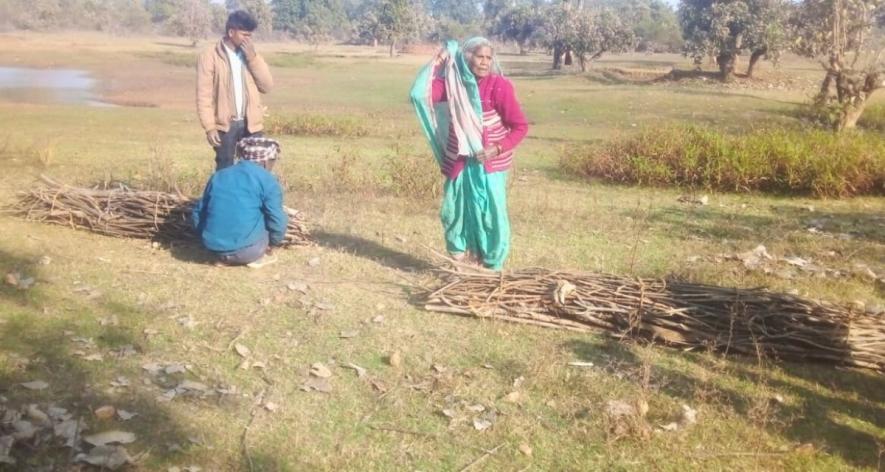
Baiga artists earning some income by cutting wood (Photo - Satish Bhartiya, 101Reporters).
Like others in Lorha, she still supplements her income with woodcutting, labour, mahua collection and tendu-leaf gathering.
Even recognition at the highest levels has done little to ease these burdens. “Big honours like the Padma Shri are only ornaments of popularity and recognition,” Amar said. “They don’t come with money to improve basic needs.” His mother, Sakun Bai, added: “The government and organisations are giving awards and honours, but to change our situation we need free exhibition spaces in big cities and abroad, training, technical understanding of art, and a market. Wealthy middlemen have control over those things, and they are usurping our rights.”
Barriers
Experts say the barriers are structural. “Illiteracy, lack of awareness, poor publicity, and weak ground-level outreach prevent government schemes from reaching these artists,” said Dr Akash Malviya, assistant professor of fine arts at Dr Harisingh Gaur University. “The government needs to prioritise this work even more. These tribal artists should be protected from middlemen, and arrangements made for their regular income so they can promote their art. The income should be transferred directly, not through intermediaries.”
Dr Malviya and other local non-government organisations have attempted to create platforms through university outreach and craft fairs, but coverage remains uneven. Schemes such as One District One Product (ODOP) and the Tribal Cooperative Marketing Development Federation of India (TRIFED) exist on paper but their benefits are yet to reach the artists in villages like Lorha.
Satish Bhartiya is a freelance journalist and a member of 101Reporters, a pan-India network of grassroots reporters.
Get the latest reports & analysis with people's perspective on Protests, movements & deep analytical videos, discussions of the current affairs in your Telegram app. Subscribe to NewsClick's Telegram channel & get Real-Time updates on stories, as they get published on our website.















